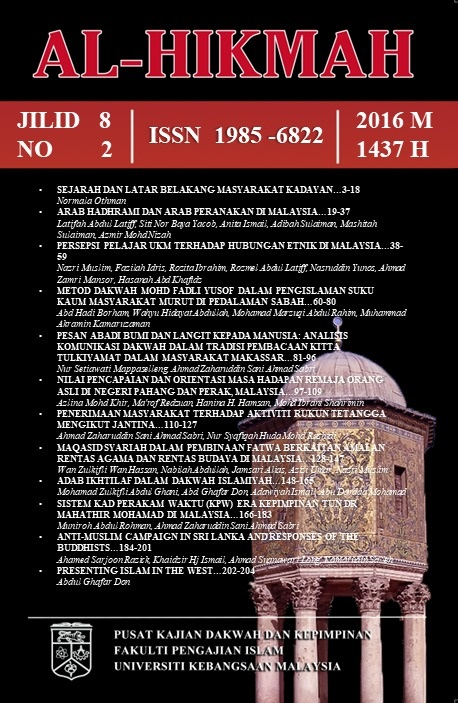ACHIEVEMENT VALUE AND FUTURE ORIENTATION AMONG ORANG ASLI ADOLESCENTS IN THE STATES OF PAHANG AND PERAK, MALAYSIA
Nilai Pencapaian dan Orientasi Masa Hadapan Remaja Orang Asli di Negeri Pahang Dan Perak, Malaysia
Abstract
This study was conducted to identify the level of achievement value and future orientation amongOrang Asli Adolescents. It is also to determine the differences of achievement value and future orientation according to academic achievement. This study involved 402 Orang Asli adolescents in the state of Pahang and Perak, who were selected through multi-stage sampling technique. Data were collected using questionnaires through a self-administered procedure with minimal monitoring by researcher. The study found that respondents were averagely weak in their studies, and have moderate level of achievement value and future orientation. This study also indicated that the achievement value (F(2, 399) = 11.14; p < 0.01) and future orientation (F(2, 399) = 28.11; p < 0.01) showed significant differences based on academic achievement. Respondents who achieved higher level in academic also possess higher level of achievement value and more optimist in future orientation compare to their friends who obtained lower level of academic achievement. As a conclusion, psychological factors such as achievement value and future orientation are closely related to academic achievement. Thus, in order to improve the academic performance of Aboriginal students, both factors should be given attention.
References
Azlina, M. K. (2010). Hubungan antara sistem nilai dengan sikap dan motivasi pencapaian komuniti Melayu miskin bandar dan luar bandar. Tesis Sarjana, Universiti Kebangsaan Malaysia.
Chang, E. C., & Sanna, L. J. (2003). Experience of life hassles and psychological adjustment among adolescents: Does it make a difference if one is optimistic or pessimistic? Personality & Individual Differences, 34 (5), 867-879.
Cozzarelli, C., Wilkinson, A., & Tagler, M. J. (2001). Attitudes toward the poor and attributions for poverty. Journal of Social Issues, 57(2), 207-227.
Ey, S., Hadley, W., Allen, D.N., Palmer, S., Klosky, J., Deptula, D., Thomas, J.,& Cohen, R. (2005). A new measure of children’s optimism and pessimism: The youth life orientation test. Journal of Child Psychology and Psychiatry (46)5, 548-558.
Jabatan Kemajuan Orang Asli. (2011). Pelan Strategik Komuniti Orang Asli: 2011-2015. Kuala Lumpur: Bahagian Perancangan dan Penyelidikan Jabatan Kemajuan Orang Asli.
Malaysia. (2011). Rancangan Malaysia Kesepuluh 2011-2015. Kuala Lumpur: Percetakan Negara.
Ma’rof, R. (2010). Pembangunan dan kemunduran komuniti peribumi: Kes kemiskinan dalam komuniti Orang Asli. Dalam Laily, P. & Sharifah, A. H. (Pyt.), Kemiskinan di Malaysia: Isu Fundamental dan Paparan Realiti (pp. 96-131). Serdang, Malaysia: Penerbit Universiti Putra Malaysia.
Peterson, C. (2000). The future of optimism. American Psychologist, 55 (1), 44-55.
Santrock, J. W. (2008). Adolescence (12th ed.). New York: McGraw-Hill.
Scheier, M. F., & Carver, C. S. (1992). Effects of optimism on psychological and physical well-being: Theoritical overview and empirical update: Cognitive Therapy and Research, 16, 201-228.
Scheier, M. F., Carver, C. S., & Bridges, M. W. (1994). Distinguishing optimism from neuroticism: A reevaluation of the Life Orientation Test. Journal of Personality and Social Psychology, 67, 1063-1078.
Schwartz, S. H. (1992). Universals in the content and structure of values: Theory and empirical test in 20 countries. In M. Zanna (Ed.), Advances in experimental social psychology (25), 1-65. New York: Academic Press.
Schwartz, S. H. (2012). An overview of the Schwartz Theory of Basic Values. Online Reading in Psychology and Culture, 2(1). http://dx.doi.org/10.9707/2307-0919.1116. Retrieved 20 September 2013.
Trommsdorff, G., Burger, C., & Fuchsle,T. (1982). Social and psychological aspects of future orientation. In M. Irle (Ed.), Studies in decision making: Social psychological and socio-economic analyses (pp. 167-194). New York, NY: Walter de Gruyter.
Trommsdorff, G., & Lamm, H. (1980). Future orientation of institutionalized and noninstitutionalized deliquents and nondeliquents. European Journal of Social Psychology, 10, 247-278.
Copyright (c) 2016 Al-Hikmah

This work is licensed under a Creative Commons Attribution-NonCommercial-NoDerivatives 4.0 International License.
Authors retain copyright and grant the journal right of first publication with the work simultaneously licensed under a Creative Commons Attribution License (CC BY-SA 4.0) that allows others to share the work with an acknowledgement of the work's authorship and initial publication in this journal.





